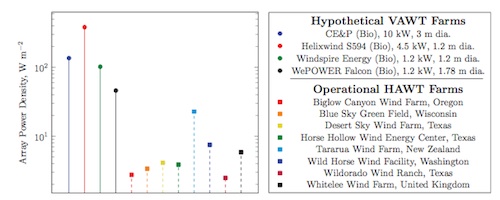“Schools” of 30-foot vertical axis turbines may outperform standard 300-foot wind farms
Science, Wind turbines Add commentsThis is pretty amazing: researchers at CalTech working in biomimicry have completed the first field trials of an array of small vertical axis wind turbines, in which they pack the arrays tightly together, aiming to take advantage of possible boosts in output created by capturing the vortex flow patterns from each other. The concept is modeled on studies of fish schools, and the realization that the move far more efficiently through the water than do individual fish. Air pattern modeling and initial field tests suggest that these tightly packed arrays may generate 100watts per square meter, ten times the energy density of today’s industrial wind farms. This could mean more energy in the same area, or, more likely, the same or somewhat more energy using far less land than today’s wind farms use. With machines that are quieter and only 30 feet tall!

Energy per unit area of proposed tightly packed small turbines vs. several existing utility-scale windfarms
Each 30-foot turbine generates only around a kilowatt of output, as compared to today’s massive 1500-2500kw industrial turbines; this is the reason that all the many vertical axis designs have been considered only useful for home use, rather than utility-scale generation. But the fish-inspired layout produced far more power per square meter of land used than today’s wind farms. The first field test was small, just six turbines, it confirmed the vortex flow models that the team had developed earlier after careful measurements of air flow around a single turbine. The next step in the research is to work with arrays of 1000 turbines, which should generate power on the megawatt scale. Amazingly, these arrays will occupy a much smaller footprint than a single huge horizontal axis turbine.
For more on this enticing research, see this article in Conservation magazine, this article about one of the researchers, who is a recently announced MacArthur Fellow also developing vortex propellors, or download their most recent paper (from which the graphic above is drawn) and see for yourself!
